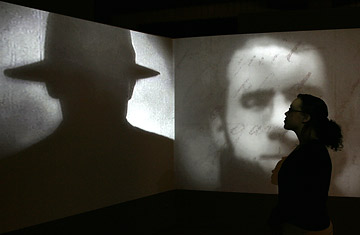
“The first thing I noticed was that she was ripped up like a pig in the market,” her entrails “flung in a heap about her neck.” Thus the account in London’s Star newspaper of the policeman who found the body of Catherine Eddowes, a prostitute murdered in the autumn of 1888 by the serial killer the media dubbed “Jack the Ripper.” But if the Ripper’s notoriety was fueled by a fiercely competitive media market with newspapers trying to outdo one another in relaying gory details of the crimes, unearthing clues, floating theories and taunting the police, his killing spree remains an object of fascination more than a century later — not least because it was the exploits of “The Ripper” that first acquainted comfortable middle-class London with life on the city’s dark underside.
“The crimes and the killer are intertwined with London’s identity and history,” says Julia Hoffbrand, co-curator a new major exhibition, “Jack the Ripper and the East End,” at London’s Museum in Docklands. Of the many hardscrabble neighborhoods of Dickensian London, none was more blighted than Whitechapel, a grim, crowded East End hellhole, rife with poverty, disease, crime and homelessness. Prostitution was widespread; alcohol was plentiful. Whitechapel as an ominous, foggy maze of gaslit, cobbled streets, alleys and dead ends “is still very much the public image of the East End now,” says Hoffbrand.
Most middle-class and wealthy Londoners were blissfully ignorant of conditions in Whitechapel until the autumn of 1888, when Scotland Yard realized that a serial killer was loose in the area, and Fleet Street helped create the legend — and even the name — of the knife-wielding “Ripper.” Until the brutal slayings ended some two and a half years later, sensationalistic coverage of the Ripper was relentless, his exploits recounted by reporters and artists in a manner that exposed the squalor of Whitechapel to a fascinated audience — and shaped London’s perception of the East End. Playwright George Bernard Shaw once remarked that Jack the Ripper did more than any social reformer to draw attention to the intolerable conditions of Whitechapel’s slums.
The new Ripper exhibit recounts the unsolved murders through the prism of life in Victorian Whitechapel, using photographs, police files and press reports to bring the era to life. It also shows how the Ripper’s 11 victims — all alcoholics who turned to prostitution — were brought down by slum life before falling prey to a murderer. A police list of Catherine Eddowes’ clothing and possessions is both mundane and poignant: A gray petticoat, “a very old ragged blue skirt,” and a pair of men’s lace-up boots.
Also on display is the notorious “Dear Boss” letter, written in blood-red ink and sent to the Central News Agency. It purported to be from the murderer, promised more killings, and was signed, “Yours Truly, Jack the Ripper.” The letter was republished by many papers, though police considered it hoax, possibly written by a journalist. Still, the name stuck. “It seized the public’s imagination,” Hoffbrand says. It also resulted in a torrent of other gruesome — and probably fake — letters being sent to newspapers and police, each purporting to be from the killer.
In those pre-forensic science days, the police could do little more than flood Whitechapel with bobbies, take witness statements and gather evidence for the coroner. Scotland Yard successfully tested a pair of bloodhounds, but never used them in the investigation. But police did make use of photography for the first time. Grisly photos of a mutilated Mary Ann Kelly were probably the first crime-scene photos ever taken.
The exhibition includes the more well-known suspects, but makes no attempt to solve the case. “It’s not a whodunit,” Hoffbrand says. Actually, 120 years after the fact, it doubtful anyone really wants to see the world’s most famous murder mystery solved. That might spoil the rich legacy of Jack the Ripper. And rich it certainly is — a multimillion-dollar industry, featuring periodicals, chatrooms, websites, conventions and the countless books that continue to be written on the subject. The murders have also inspired numerous films, plays and TV dramas, even several stage musicals.
These days, a visitor to Whitechapel would be hard-pressed to avoid one of the myriad Jack the Ripper walking tours crisscrossing its narrow streets. One operator, London Walks, says of the 140 tours it offers, the Ripper walk “is by far the most popular,” the only one scheduled seven evenings a week. “He’s almost become a fictional character,” Hoffbrand says. “We’re obsessed with him.”